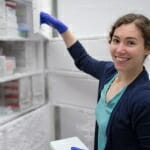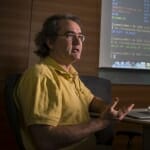Teams from Wisconsin, New York search for molecular clues to defeat COVID-19
In the center of the COVID-19 pandemic, hospitals are racing to maintain quality care for patients with severe disease while facing a shortage of resources and limited understanding of the novel coronavirus.
One physician on the front lines — Ariel Jaitovich, a pulmonary and critical care physician at the Albany Medical Center in New York — sought out a collaboration with investigators at the Morgridge Institute for Research and the Department of Biomolecular Chemistry at the University of Wisconsin School of Medicine and Public Health (SMPH) to better understand the molecular profile of COVID-19 and provide insights that may improve treatment.
“It’s a new disease. Two months ago, we knew nothing about it,” says Jaitovich. “What we are trying to do now is do systematic work to better understand what this disease is about.”
By analyzing approximately 150 patient COVID-19 samples from the Albany Medical Center, the collaborative research team is hoping to better understand what factors influence whether a patient will suffer from complications such as acute respiratory distress syndrome (ARDS).
One example is the immunological concept of a cytokine storm — where the inflammatory response of the immune system goes into overdrive — as a possible trigger for ARDS.
“There’s no clear understanding of whether these people who do really bad are the ones who have a toxic level of inflammation … if this cytokine storm is necessarily associated with worse outcomes in COVID patients,” Jaitovich says.
Jaitovich reached out to Morgridge investigator, SMPH professor, and mass spectrometry expert Josh Coon to help because, he says, “Josh runs one of the most sophisticated and advanced labs to investigate proteins.”
Coon leads the Laboratory for Biomolecular Mass Spectrometry at UW–Madison and had been looking for a way to leverage his lab’s technology to help with the pandemic. The lab’s efforts will be managed by LBMS associate director Katie Overmyer and assistant staff scientist Evgenia Shishkova.
“It’s what we do. We take a problem, we apply our technologies. We help our collaborators solve this problem,” says Overmyer.
The research team is using an approach called mass spectrometry to measure lipids, proteins and other small molecules called metabolites in samples from patients hospitalized with COVID-19. They will be compared to control samples from hospitalized patients who tested negative for COVID-19.
The technology allows scientists to identify different compounds and better understand their properties. Coon says it may help them identify molecular signals that might distinguish a mild case from a severe case.
“What we are trying to do now is do systematic work to better understand what this disease is about.”
Ariel Jaitovich
Much of the previous research on coronaviruses and influenza has typically focused on proteomics (proteins), lipidomics (lipids) and metabolomics (metabolites) separately, Overmyer notes. “This multi-omic approach is fairly new and not well adopted yet,” she says. “I think that’s going to be the really powerful tool here, to be able to link those and maybe make better inferences about what’s going on than a single [approach] would allow.”
In addition to the cytokine storm process, Coon says there are other potential indicators of disease severity that involve blood clotting factors in the vessels of the lung. The research team hopes that studying the different proteins, metabolites and lipids involved in these unique disease mechanisms can reveal more about what is happening in patients with COVID-19.
“Can we stratify those patients based on those molecular measurements and help predict what an outcome might be? I think those are the overall goals: to really try to understand what’s happening at a molecular level,” Coon says.
While the Coon laboratory works on characterizing the molecular signatures, Jaitovich’s team will also work to identify the genetic influences on the disease. To analyze this data, which involves RNA sequencing, Jaitovich is collaborating with Morgridge bioinformatics experts Ron Stewart and Scott Swanson.
“We should be able to get an idea about what genes or gene sets are involved in things like inflammation, and how that might differ between COVID-19 and other ARDS cases,” says Stewart, principal investigator and associate director of bioinformatics at Morgridge.
Swanson will lead the analysis to determine if there are unique gene expression profiles that might differ between the mild and severe cases. “I can look at those genes, and we have all kinds of databases available to us that tell us about which genes are related to different physiological characteristics,” he says. “We’re following the footsteps of established techniques that have produced results in this specific domain of ARDS, if not necessarily for coronaviruses. So, I’m optimistic that something intelligible and meaningful will come out of even just that first pass of analysis.”
By combining the mass spectrometry data with the RNA sequencing data, Jaitovich says the ultimate outcome of this project is to identify potential targets to help treat the disease.
“This is extremely important for many reasons, because you can, for example, intervene early with people who are more likely to do worse over time based on these early identified markers,” he says. “You can better allocate resources in a moment in which there is a shortage of resources to deal with this pandemic.”
The team is working to analyze patient samples as soon as they arrive.
“Certainly, as long as we’ve been in business … there’s never been a pandemic like this with such urgency to really come up with a scientific solution,” says Coon.
“It is difficult, because we deal with real-world problems of patients who are suffering from it or losing loved ones. You know, a lot of anxiety,” says Jaitovich. “On the other hand, there is a lot of support, including health care workers, patients and families. There is massive support by the institution’s leadership … they are all committed to working together toward the common goal: alleviating people’s suffering.”








